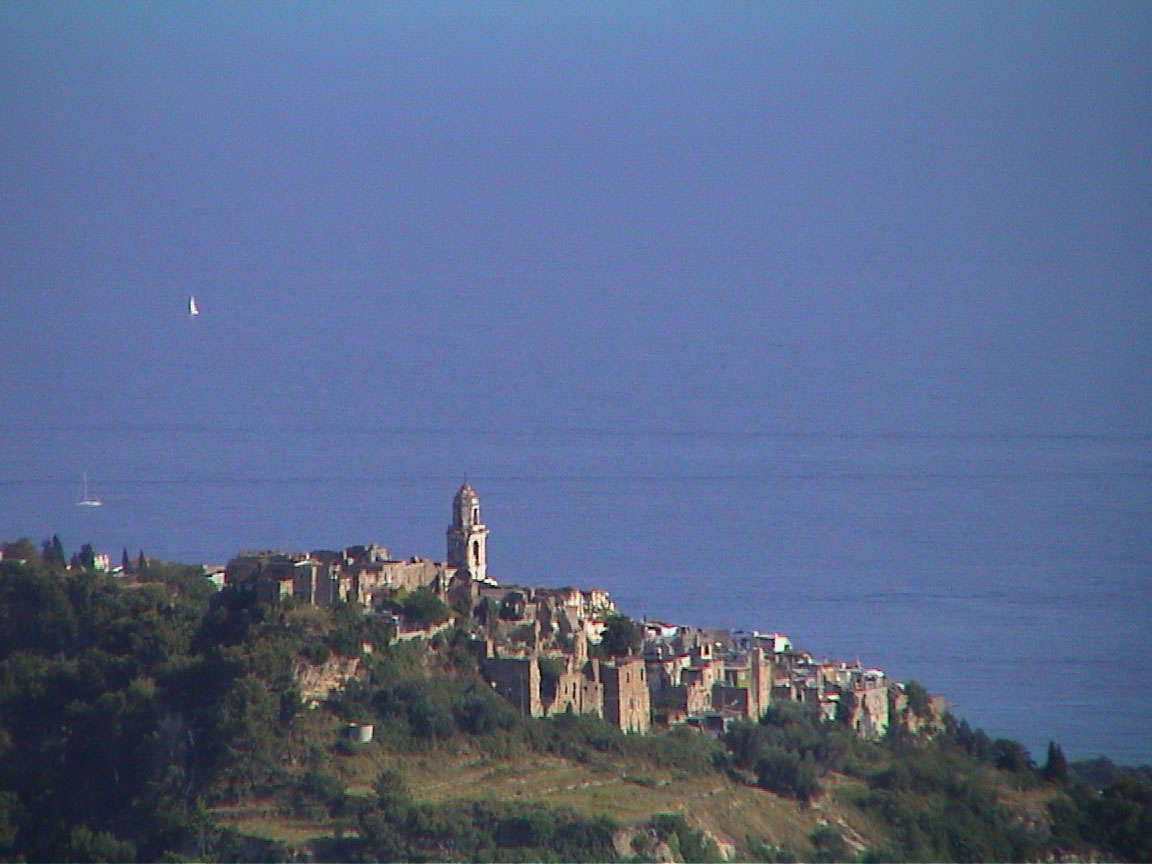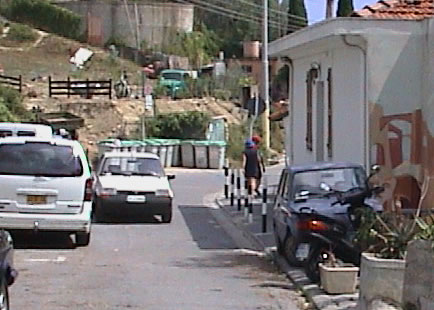Updated:
May 2, 2003
Bussana Vecchia Village
 The
village of Bussana Vecchia stems from the Middle Age. That is the clear part.
It is not clear when it was built in those days. The most logical story about
the founding of the village is in the 9th century, when local fisherman living
with their families on the coast were frequently attacked/ raided/ murdered
/ raped by various arab tribes from North Africa. To avoid these attacks and
have better visibility they moved up the lower hills and built houses that had
fortified walls with only small windows on the outside. One story states that
there was a castle in those days on the Bussana hilltop and that houses were
built adjacent to the castle to gain protection. Another story claims that the
castle was only built later and that the first houses in the village were built
as stand-alone fortified houses. A fact is that some people in the inland towns
like Badalucco have a very dark complexion which underwrites the Arab (or perhaps
Saracene) theory. The dominance of the Arabs was around the 9th century, so
the date indication for the first sections of town are probably correct.
The
village of Bussana Vecchia stems from the Middle Age. That is the clear part.
It is not clear when it was built in those days. The most logical story about
the founding of the village is in the 9th century, when local fisherman living
with their families on the coast were frequently attacked/ raided/ murdered
/ raped by various arab tribes from North Africa. To avoid these attacks and
have better visibility they moved up the lower hills and built houses that had
fortified walls with only small windows on the outside. One story states that
there was a castle in those days on the Bussana hilltop and that houses were
built adjacent to the castle to gain protection. Another story claims that the
castle was only built later and that the first houses in the village were built
as stand-alone fortified houses. A fact is that some people in the inland towns
like Badalucco have a very dark complexion which underwrites the Arab (or perhaps
Saracene) theory. The dominance of the Arabs was around the 9th century, so
the date indication for the first sections of town are probably correct.
What conflicts with this theory is
the Stoccofisso festival held mid September every year in Badalucco (see regional
info). The Badaluccans bought the stoccofisso from Norwegian trading ships.
Even though Norman trading (and general dominance) peaked around 1070, the Badalucco
siege only happened somewhere in the 15th century.
Bussana Vecchia is also located on
a major trading route from the coast to the Piemonte region that probably was
used already in Roman days. The most likely scenario is that the village started
around an inn in the days of the Romans, and the castle was built later in the
first millennium to overlook the trade route. The present houses were probably
built between the 12th and 15th century, while the main church was built a bit
later on top of the remnants of some of the original houses.
Several websites are dedicated to
Bussana Vecchia, so at present it does not make sense to copy them here.
Check out, for example:
http://www.bussanavecchia.com/
http://www.europaproductions.com/bussana.htm,
http://bussanavecchia.free.fr/art.htm
http://www.sanremonet.com/sanremo/bussana/dove.htm
http://www.apt.rivieradeifiori.it/colori/eng09.html
Below is a map of the town with some
basic references and names.

The village has only small, cobble
stone roads and only few locals drive their tiny car into the village, usually
to park at the square behind the small church. Everyone else needs to find a
parking spot along the road ending at the village. In summer, the closer you
get to the village the smaller the chances are you'll find a parking spot and
the larger the chances are someone is heading in your direction from the opposite
side on the single-lane road.
On a busy day, you'll find cars parked several hundred meters before the village,
near the Bussana Nuova cemetary. For loading/ unloading people usually put their
car at the village entrance. Alessandra from the Creperie has a medium compact
Fiat car and drives it up to the front of her store to unload. If you have an
older car and do not worry about a scratch here and there you can do that as
well. I used to do the same with my Renault 5.
 On
the left hand side, just before the Casacchia restaurant coming from the village,
are the containers for your garbage. You need to put your garbage in there yourself
as no one will collect it in the village.
On
the left hand side, just before the Casacchia restaurant coming from the village,
are the containers for your garbage. You need to put your garbage in there yourself
as no one will collect it in the village.
A little before these garbage containers
is a strict "No Park" area, because this is the only place where one
could still do a U-turn with their car. If you break this rule, as sometimes
done by people arriving late at night to go to the Osteria or people who do
not care about these things in general, you may be the lucky person who will
find his/her car with a flat tire which has been done by letting the air out.
If you're less lucky you may find several tires punctured. This happens only
once every year or so.
Local customs, galleries and eating
places
Check out the town for yourself. Some art galleries are great, some are
more into kitch or junk. Every year some people have moved out and new people
take their place in the galleries. The village is described in every tourist
book as a "must-see" artist village. Especially on a partially cloudy
Sunday it can be stormed by hundreds of tourists, which is great for the business,
so you should support this where possible.
Try not to block the entrance to a gallery when you're chatting with the artist,
and if you have a glass of wine at the house it is often appreciated to offer
the local folks a glass as well. For birthdays or just celebrations without
cause we usually set up a table, either at the campagnetta (grassy piece of
land in front of the Osteria) or at the Piazetta Verde, which is the little
place in front of the house. A glass of wine, some salami, (water) melon, the
small local olives, small pieces of focaccia are all welcome at these events.
There are three restaurants
in town. The most laid back is Massimo's Osteria
next door (actually, Kirstin's gelateria artiginale is in between). The food
is basic but decent. The wine is the same as the one sold by Peter (Peter was
first), and as long as it is not fully loaded with tourists the service is OK.
After a hectic Saturday afternoon and evening, most dishes may be sold out and
Massimo may have difficulty remembering what you had for dinner. Just remember
what you had and let him know the next day when he has more time. Expect to
pay € 30 per person for 3-course meal.
Dinner in this part of Italy never
starts before 19.30, by the way. Restaurants will only start filling up after
8 o'clock and people will have dinner until far after midnight. In earlier days,
it was not uncommon to have a little morning snack in the form of mussels or
a pizza at 3 in the morning after you were kicked out of the disco. Those days
seem to be over.
The second eating place is the Casacchia,
at the entrance of the village. Food is regarded as quite good but at substantially
higher price than the Osteria. Expect to pay € 50 per person.
In the village, opposite the large
church, is a restaurant specializing in "eco-gastronomic" food or
something close to that. Our experiences have been positive but already a while
ago, and pricing was on the high side. Expect to pay € 50 per person.
See the Eating
Out Section for more restaurants.
 The
village of Bussana Vecchia stems from the Middle Age. That is the clear part.
It is not clear when it was built in those days. The most logical story about
the founding of the village is in the 9th century, when local fisherman living
with their families on the coast were frequently attacked/ raided/ murdered
/ raped by various arab tribes from North Africa. To avoid these attacks and
have better visibility they moved up the lower hills and built houses that had
fortified walls with only small windows on the outside. One story states that
there was a castle in those days on the Bussana hilltop and that houses were
built adjacent to the castle to gain protection. Another story claims that the
castle was only built later and that the first houses in the village were built
as stand-alone fortified houses. A fact is that some people in the inland towns
like Badalucco have a very dark complexion which underwrites the Arab (or perhaps
Saracene) theory. The dominance of the Arabs was around the 9th century, so
the date indication for the first sections of town are probably correct.
The
village of Bussana Vecchia stems from the Middle Age. That is the clear part.
It is not clear when it was built in those days. The most logical story about
the founding of the village is in the 9th century, when local fisherman living
with their families on the coast were frequently attacked/ raided/ murdered
/ raped by various arab tribes from North Africa. To avoid these attacks and
have better visibility they moved up the lower hills and built houses that had
fortified walls with only small windows on the outside. One story states that
there was a castle in those days on the Bussana hilltop and that houses were
built adjacent to the castle to gain protection. Another story claims that the
castle was only built later and that the first houses in the village were built
as stand-alone fortified houses. A fact is that some people in the inland towns
like Badalucco have a very dark complexion which underwrites the Arab (or perhaps
Saracene) theory. The dominance of the Arabs was around the 9th century, so
the date indication for the first sections of town are probably correct.
 On
the left hand side, just before the Casacchia restaurant coming from the village,
are the containers for your garbage. You need to put your garbage in there yourself
as no one will collect it in the village.
On
the left hand side, just before the Casacchia restaurant coming from the village,
are the containers for your garbage. You need to put your garbage in there yourself
as no one will collect it in the village.